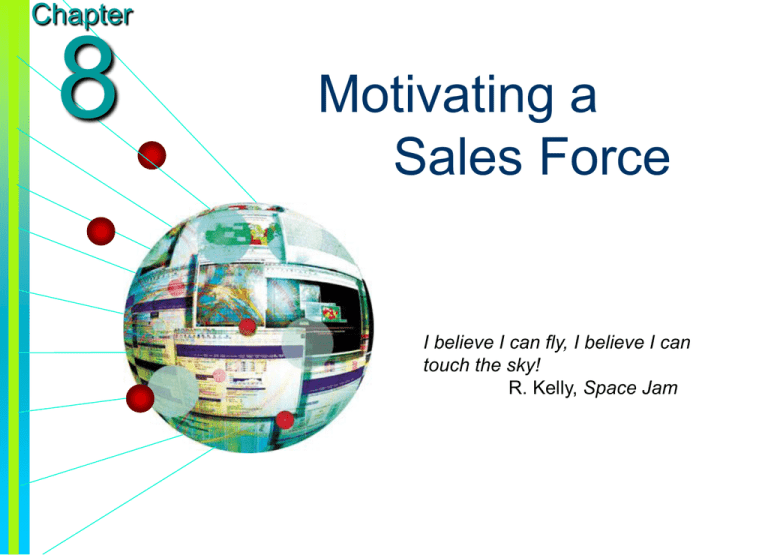
Chapter
8
Motivating a
Sales Force
I believe I can fly, I believe I can
touch the sky!
R. Kelly, Space Jam
Copyright © 2003 by The McGraw-Hill Companies, Inc. All rights reserved.
MOTIVATION IS THE CHOICE OF AN
INDIVIDUAL TO…
1. Initiate action on a certain task … choice;
2. Expend a certain amount of effort on that task
… intensity;
3. Persist in expending effort over a period of
time … persistence.
The amount of effort the sales person desires to
expend on each activity associated with the
job.
Copyright © 2003 by The McGraw-Hill Companies, Inc. All rights reserved.
Fig. 8-2 Motivational Conditions
Are the
rewards
worth the
effort?
NO
YES
Does better
YES
performance
lead to greater
rewards?
NO
Does more effort YES
lead to better
performance?
NO
The same or less effort
Copyright © 2003 by The McGraw-Hill Companies, Inc. All rights reserved.
GREATER
EFFORT
Fig 8-3 Maslow’s Hierarchy of Needs…
Fulfilled through:
Self-development,
challenge.
Managerial actions:
Provide/offer advanced
training, assignments to special
projects, more responsibility and
authority.
Fulfilled through: Status, recognition.
Managerial actions: Recognize sales rep achievements
personally and publicly through title changes, commendation
letters, promotions.
Fulfilled through: Affiliation, friendship, acceptance.
Managerial actions: Use team selling, hold social functions, distribute
employee newsletters, hold sales meetings, mentoring.
Fulfilled through: Job security, safety, income security.
Managerial actions: Provide safe work environment, set mutually agreed-upon
performance standards, communicate job performance expectations and consequences
of failure to perform.
Fulfilled through: Food, shelter, clothing, health care.
Managerial actions: Provide/offer adequate income and good benefits package.
Copyright © 2003 by The McGraw-Hill Companies, Inc. All rights reserved.
Hertzberg’s Dual-Factor Theory
HYGIENE FACTORS
MOTIVATION FACTORS
•
pay
•
recognition
•
company policies
•
responsibility
•
supervision conditions
•
challenge
•
work
•
growth opportunities
Copyright © 2003 by The McGraw-Hill Companies, Inc. All rights reserved.
Fig. 8-5 Salespeople’s Perceived Reasons for Failure and Their
Motivational Impact
Motivational impact
Negative
Perceived reasons
Positive
Ability
Seek help; get
Become frustrated
additional training;
and discouraged;
ask for supervisor’s
give up
assistance; increase effort
Effort
Work harder; make
more calls; work
longer hours
No change in behavior
Strategy
Change selling
strategy; adapt the
presentation
No change in behavior
Task difficulty
Work harder;
change strategies;
or seek help
Become frustrated
and discouraged;
give up
Luck
No change in behavior
Avoid the situation
Copyright © 2003 by The McGraw-Hill Companies, Inc. All rights reserved.
Career Stages
Exploration
Establishment
Primary concern is improving skills and performance
Lack of promotion may cause disengagement or quitting
New commitments make pay important
High expectancy instrumentality, high valence for promotion and pay
Maintenance
Primary concern is finding a suitable occupation
Underdeveloped skills and knowledge
Many drop out or are terminated
Low expectancy instrumentality, high valence for personal growth
Primary concern is maintaining position, status, and performance
Have highest sales volumes and percentage of quota and pay
High valence for recognitions, respect, and pay
Low valence for promotion
Disengagement
Primary concern is preparing for retirement and/or developing outside interest
Low valence for higher order and lower order rewards
Low instrumentality
Copyright © 2003 by The McGraw-Hill Companies, Inc. All rights reserved.
Sales Contest Design Elements
Promote &
Publicize
Sales
Contest
Design
Equally
Attainable
Goals
Copyright © 2003 by The McGraw-Hill Companies, Inc. All rights reserved.
Attractive
Variety of
Prizes
Causes of Plateauing
No
clear career path
Not managed adequately
Bored
Burned out
Economic needs met
Discouraged with company
Overlooked for promotion
Lack of ability
Avoiding risk of management job
Reluctance to be transferred
Copyright © 2003 by The McGraw-Hill Companies, Inc. All rights reserved.





